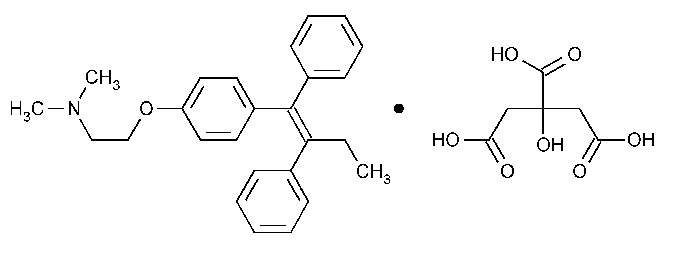Tamoxifen Citrate
Ethanamine,2-[4-(1,2-diphenyl-1-butenyl)phenoxy]-N,N-dimethyl,(Z)-,2-hydroxy-1,2,3-propanetricarboxylate (1:1).
(Z)-2-[p-(1,2-Diphenyl-1-butenyl)phenoxy]-N,N-dimethylethylamine citrate (1:1) [54965-24-1].
»Tamoxifen Citrate contains not less than 99.0percent and not more than 101.0percent of C26H29NO·C6H8O7,calculated on the dried basis.
Packaging and storage—
Preserve in well-closed,light-resistant containers.
Identification—
A:
Infrared Absorption á197Kñ:a single band in the 1700to 1740cm-1region of the spectrum.
Solution:
20µg per mL.
Medium:
methanol.
Loss on drying á731ñ—
Dry it at 105 for 4hours:it loses not more than 0.5%of its weight.
for 4hours:it loses not more than 0.5%of its weight.
Residue on ignition á281ñ:
not more than 0.2%.
Limit of E-isomer—
Mobile phase—
Prepare a methanol solution containing,in each liter,320mLof water,2mLof glacial acetic acid,and 1.08g of sodium 1-octanesulfonate.
Standard preparation—
Dissolve a suitable quantity,accurately weighed,of USP Tamoxifen Citrate RSin Mobile phaseto obtain a solution having a known concentration of about 600µg per mL.
Test preparation—
Using about 30mg of Tamoxifen Citrate,accurately weighed,proceed as directed under Standard preparation.
Chromatographic system
(see Chromatography á621ñ)—The liquid chromatograph is equipped with a 254-nm detector and a 4-mm ×30-cm column that contains packing L11.The flow rate is about 0.7mLper minute.Chromatograph five replicate injections of the Standard preparation,and record the responses of the major peak:the relative standard deviation is not more than 3.0%,and the relative retention time of the minor E-isomer peak to that of the Z-isomer peak is not greater than 0.93.
Procedure—
Separately introduce equal volumes (about 20µL)of the Test preparationand the Standard preparationinto the liquid chromatograph by means of a suitable sampling valve.Measure the minor peak responses for the E-isomer obtained from the Standard preparationand the Assay preparation.Calculate the quantity,in mg,of E-isomer (C26H29NO·C6H8O7)in the portion of Tamoxifen Citrate taken by the formula:
0.05C(rU/rS),
in which Cis the concentration,in µg per mL,of the E-isomer as the citrate,based on its declared content in USP Tamoxifen Citrate RSin the Standard preparation,and the rUand rSare the minor peak responses obtained from the Assay preparationand the Standard preparation,respectively.The E-isomer content is not more than 0.3%of tamoxifen citrate (C26H29NO·C6H8O7).
Iron á241ñ—
Accurately weigh 1.0g,and transfer to a suitable crucible.Add sufficient sulfuric acid to wet the substance,and carefully ignite at a low temperature until thoroughly charred.(The crucible may be loosely covered with a suitable lid during the charring.)Add to the carbonized mass 2mLof nitric acid and 5drops of sulfuric acid,and heat cautiously until white fumes no longer are evolved.Ignite,preferably in a muffle furnace,at 500 to 600
to 600 ,until the carbon is completely burned off.Cool,add 10mLof warm 0.1Nhydrochloric acid,and digest for about 5minutes.Transfer the contents of the crucible with the aid of small portions of water to a 50-mLvolumetric flask,dilute with water to volume,and mix.Pipet 10mLfrom the volumetric flask into a color-comparison tube,dilute with water to 45mL,add 2mLof hydrochloric acid,and mix.The limit is 0.005%.
,until the carbon is completely burned off.Cool,add 10mLof warm 0.1Nhydrochloric acid,and digest for about 5minutes.Transfer the contents of the crucible with the aid of small portions of water to a 50-mLvolumetric flask,dilute with water to volume,and mix.Pipet 10mLfrom the volumetric flask into a color-comparison tube,dilute with water to 45mL,add 2mLof hydrochloric acid,and mix.The limit is 0.005%.
Heavy metals,Method IIá231ñ:
0.001%.
Related impurities—
Test preparation A—
Disperse about 3g in 100mLof water in a separator.Over a 10-minute period add 50mLof 0.5Nsodium hydroxide,with mixing.Extract with two 50-mLportions of ether,and combine the extracts.Wash with 20mLof water,remove the water layer,and dry the ether layer over anhydrous sodium sulfate.Evaporate the ether layer under nitrogen,and dry in vacuum at room temperature for 2hours.Accurately weigh 1.5g of the residue into a 10-mLvolumetric flask,add 5.0mLof a mixture of 5volumes of acetic anhydride and 95volumes of pyridine,and heat at 60 for 10to 15minutes.Cool,dilute with the same solvent mixture to volume,and mix.
for 10to 15minutes.Cool,dilute with the same solvent mixture to volume,and mix.
Test preparation B—
Using the same acetic anhydride-pyridine mixture,prepare a 1:200dilution of Test preparation A.
Chromatographic system
(see Chromatography á621ñ)—Typically,the gas chromatograph is equipped with a flame-ionization detector,and contains a 4-mm ×1-m glass column packed with 5%liquid phase G17on 100-to 120-mesh support S1ABconditioned at 300 for 24hours.The column and injection port temperatures are maintained at about 260
for 24hours.The column and injection port temperatures are maintained at about 260 and the detector temperature at about 300
and the detector temperature at about 300 .Dry helium is used as the carrier gas at a flow rate of about 60mLper minute.In a suitable chromatogram,five replicate injections of Test preparation Bshow a relative standard deviation of not more than 3.0%.
.Dry helium is used as the carrier gas at a flow rate of about 60mLper minute.In a suitable chromatogram,five replicate injections of Test preparation Bshow a relative standard deviation of not more than 3.0%.
Procedure—
Inject equal portions (about 2µL),accurately measured,of Test preparation Aand Test preparation Binto the chromatograph,and record the chromatograms from 0.1to 5.0,relative to the retention time of the major peak.Measure the individual areas of the peaks other than those produced by the solvent and the tamoxifen on the chromatograms obtained from Test preparation A,and calculate their sum.No single peak area is greater than the total area of the tamoxifen peak on the chromatogram obtained from Test preparation B(0.5%),and the sum of the peak areas is not greater than twice the total area of the tamoxifen peak on the chromatogram obtained from Test preparation B(1.0%).
Organic volatile impurities,Method Vá467ñ:
meets the requirements.
Solvent—
Use dimethyl sulfoxide.
Assay—
Weigh accurately about 1g of Tamoxifen Citrate,and dissolve in 150mLof glacial acetic acid.Titrate the solution with 0.1Nperchloric acid VS,determining the endpoint potentiometrically,using a glass indicator electrode and a silver-silver chloride reference electrode.Each mLof 0.1Nperchloric acid is equivalent to 56.36mg of C26H29NO·C6H8O7.
Auxiliary Information—
Staff Liaison:Clydewyn M.Anthony,Ph.D.,Scientist
Expert Committee:(PA1)Pharmaceutical Analysis 1
USP28–NF23Page 1847
Phone Number:1-301-816-8139
